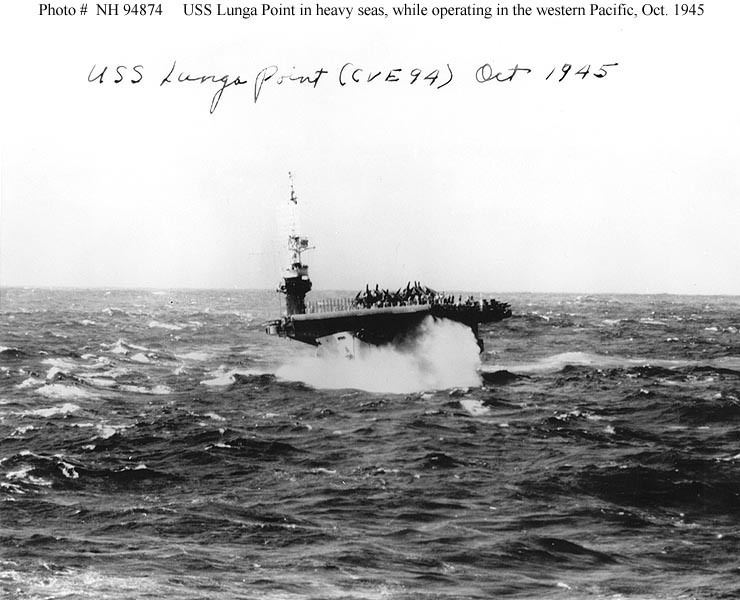Name USS Lunga Point Commissioned 14 May 1944 Struck 1 April 1960 Launched 11 April 1944 Builder Kaiser Shipyards | Laid down 19 January 1944 Decommissioned 24 October 1946 Construction started 19 January 1944 Length 156 m | |
 | ||
Fate Sold for scrap on 3 August 1960 Part of United States Pacific Fleet (1944–1946) Operations Philippines Campaign, Battle of Iwo Jima, Battle of Okinawa | ||
USS Lunga Point (CVE-94), originally Alazon Bay, was a Casablanca class escort carrier. It was named for Lunga Point on the northern coast of Guadalcanal, the site of a naval battle during World War II. It was laid down by Kaiser Shipbuilding Co., Vancouver, Washington on 19 January 1944; launched on 11 April 1944, sponsored by Mrs. Mary Elizabeth McKay; and commissioned on 14 May 1944, Captain G. A. T. Washburn in command.
Contents
World War II
Following a period of brief training during the early summer of 1944, Lunga Point sailed for the Pacific to deliver Army bombers to New Guinea and bring war-worn P-47 Thunderbolts back home. Upon return, she became a unit of Carrier Division 29 (CarDiv 29) and departed San Diego on 16 October to participate in the Leyte Gulf operations, touching Pearl Harbor, Eniwetok, and Kossol Roads en route. From 13–22 November, she provided air cover for transports and surface units engaged in the campaign. Relieved on the 23rd, she sailed to Manus Island, Admiralty Islands, to prepare for the Luzon campaign.
The escort carrier sailed on 27 December from Manus to supply air support for 6th Army landing operations at Lingayen Gulf. On 4 January 1945, she splashed one enemy aircraft and witnessed the sinking of Ommaney Bay which had been hit by Japanese planes. Fighting her way through 14 enemy attacks, she arrived off Lingayen Gulf on 6 January, and commenced 11 days of intensive air support during which time her aircraft flew an average of 41 sorties a day. On 17 January, the support carriers were withdrawn and returned to Ulithi.
From 23 January-10 February, Lunga Point prepared for the invasion of Iwo Jima, and stood off the beaches with the advanced amphibious forces 16 February. Enemy airstrikes developed in strength by 21 February, when some 16 planes attacked carriers in the vicinity. Saratoga was damaged and Bismarck Sea was sunk, but Lunga Point splashed three Nakajima B6N "Jills" while suffering only minor damage. By 8 March, land-based planes were present in sufficient strength to allow the ship to return to Ulithi to get ready for the Okinawa campaign.
The ship reprovisioned, and on 21 March sortied from Ulithi with other advanced form of Rear Admiral Clifton Sprague’s Task Unit. From 24 March-27 June, Lunga Point remained in support of the operation providing air cover, pounding enemy ground targets in the Ryukyu Islands and fighting off constant kamikaze attacks. She completed this duty without mishap, and returned to Leyte 27 June.
This was followed by a minesweeping operation west of Okinawa in early July, and an anti-shipping sweep along the China coast from Shanghai northward in August. This duty terminated the 7th, and she sailed to Buckner Bay, Okinawa, where she received news of the Japanese peace offerings.
In late August the ship, attached to the 5th Fleet, aided in evacuating Allied prisoners of war from the ports of Wakayama and Nagasaki, on 19 September she transported 760 men of various nationalities to Okinawa. She was ordered to Tokyo Bay in early October, and en route took part in the unsuccessful search for Rear Admiral W. D. Sample missing in a PBM Mariner on a patrol flight. Lunga Point stood out of Tokyo Bay 28 October, and arrived at Pearl Harbor on 7 November. She sailed to San Diego, California arriving on 15 November, and made voyages to the Pacific before returning to the west coast early in 1946.
Post-War
On 24 October 1946, the ship was decommissioned and became part of the Tacoma Group, Pacific Reserve Fleet. She was reclassified CVU-94 on 12 June 1955 and AKV-32 on 7 May 1959. She was struck from the Navy list on 1 April 1960, and sold at San Diego to Hyman Michaels Co. on 3 August 1960.
Awards
Lunga Point received five battle stars and a Presidential Unit Citation for her World War II service.
